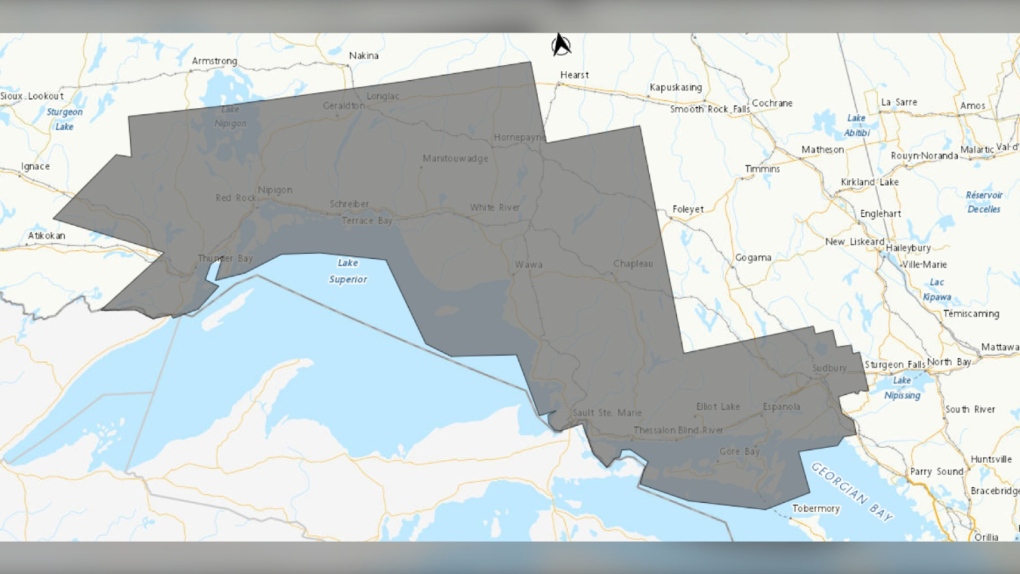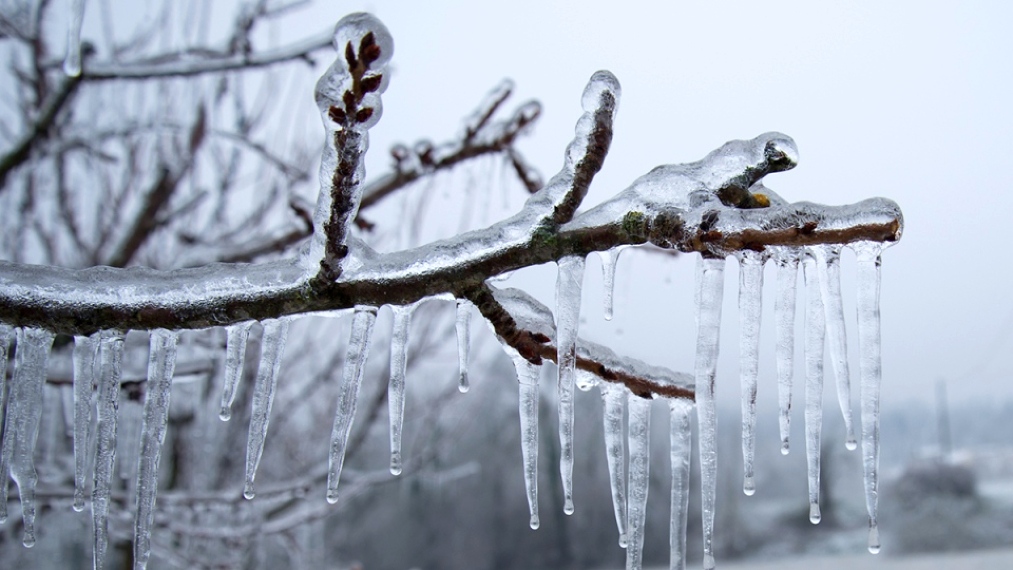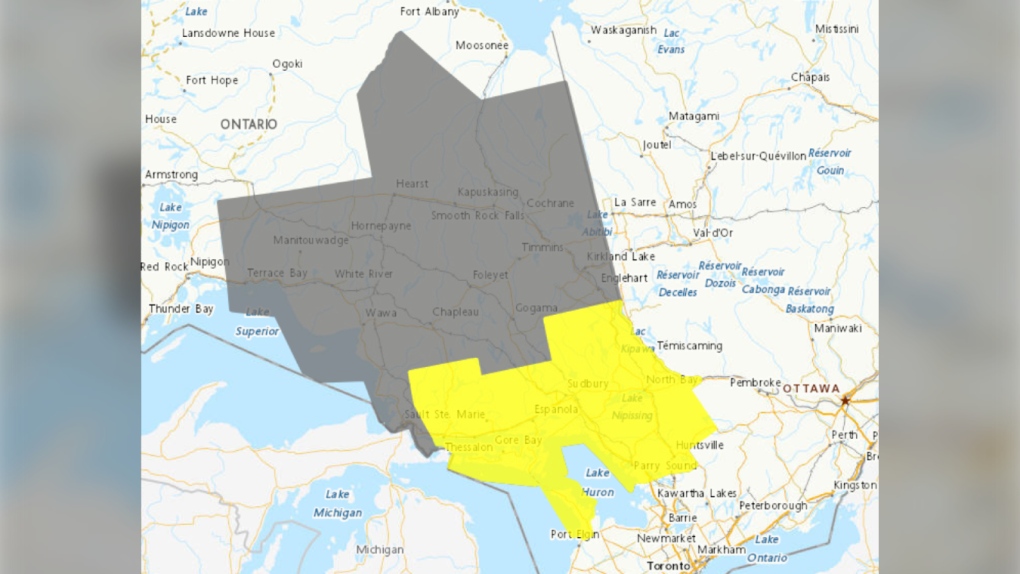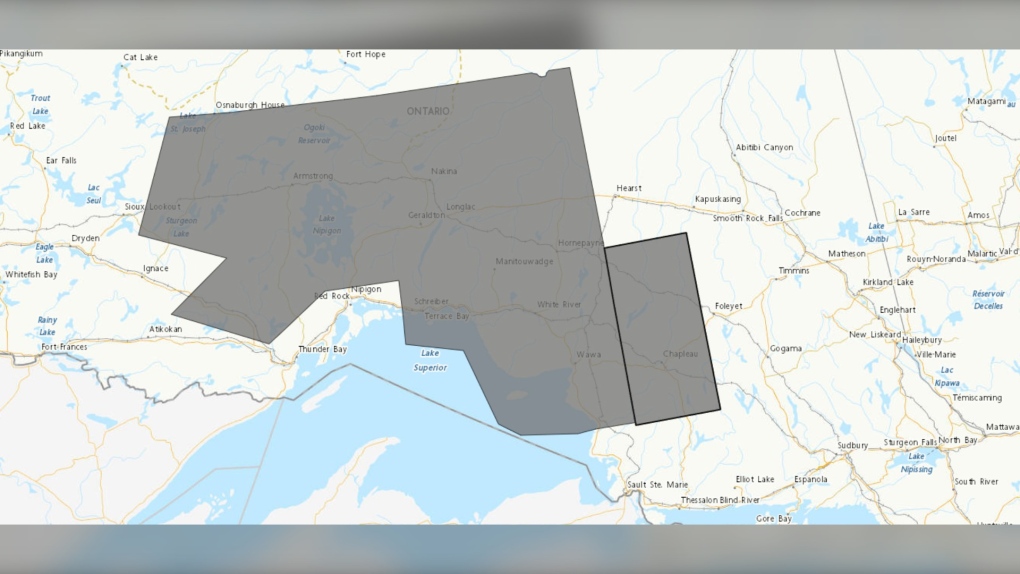Special weather statements issued in northern Ont. for freezing or heavy rain
Update:
Environment Canada has lifted the thunderstorm watches issued on Saturday for northeastern Ontario – however, has since issued special weather statements warning of freezing or heavy rain from Chapleau, Ont. to Sturgeon Lake, Ont. beginning Sunday evening into Monday afternoon.
 Weather alert map showing special weather statements (grey) in northeastern Ontario as of 5:15 p.m. on April 28, 2024. (Supplied/Environment Canada)
Weather alert map showing special weather statements (grey) in northeastern Ontario as of 5:15 p.m. on April 28, 2024. (Supplied/Environment Canada)
In statements on Sunday , weather forecasters said significant freezing rain or heavy rain is possible into Monday.
Freezing rain
As of 1 p.m., the special weather statement regarding freezing rain were in effect for the communities of Agawa, Beardmore, Black Sturgeon Lake, Caramat, Chapleau, Geraldton, Gull Bay, Hornepayne, Jellicoe, Lake Superior Park, Longlac, Macdiarmid, Manitouwadge, Marathon, Missinaibi Lake, Nipigon, Pukaskwa, Raith, Superior North, Superior West, Thunder Bay, Upsala, Wawa and White River.
“A low pressure system is expected to affect the region and a period of freezing rain and ice pellets is possible,” read the updated statement.
"For most areas freezing rain will be brief before changing to rain or snow, however areas of higher terrain may see freezing rain last slightly longer."
Hazards include ice build-up and icy surfaces due to freezing rain.
Forecasters said that power outages are possible during the weather event and the freezing rain may result in surfaces such as highways, roads, walkways and parking lots becoming slippery.
 An undated file photo of ice formed from freezing rain. (CTV News)
An undated file photo of ice formed from freezing rain. (CTV News)
- Get local breaking news alerts(opens in a new tab)
- Daily newsletter with the top local stories emailed to your inbox(opens in a new tab)
Heavy rain
As of shortly before 1:30 p.m., special weather statements were issued in the communities of Greater Sudbury and area, Manitoulin Island Sault Ste. Marie, Batchawana Bay, Blind River, Elliot Lake, Killarney, Montreal River Harbour, Ranger Lake, Searchmont and St. Joseph Island for heavy rainfall with 20 – 30mm of rain expected from Sunday evening into Monday afternoon or evening.
“A low pressure system will bring another round of rain to the area,”read the statements.
“The ground, already near saturation, has little ability to absorb further rainfall.”
Forecasters said localized flooding in low-lying areas is possible.
 Several communities in northeastern Ontario are under weather alerts for heavy rain. (File photo/CTV News)
Several communities in northeastern Ontario are under weather alerts for heavy rain. (File photo/CTV News)
To report severe weather, send an email to ONstorm@ec.gc.ca or tweet reports using #ONStorm.(opens in a new tab)
Original story:
Environment Canada(opens in a new tab) issued a severe thunderstorm watch for several communities in northeastern Ontario on Saturday afternoon – primarily the Greater Sudbury area and West Nipissing.
 Weather alert map (yellow -- thunderstorm watch and grey -- rainfall weather statement) as of 4:15 p.m. on April 27, 2024. (Supplied/Environment Canada)
Weather alert map (yellow -- thunderstorm watch and grey -- rainfall weather statement) as of 4:15 p.m. on April 27, 2024. (Supplied/Environment Canada)
The watch includes areas of North Bay,(opens in a new tab) Parry Sound, West Nipissing and Greater Sudbury and vicinity along with the communities of Bayfield Inlet, Blind River, Bruce Peninsula, Burk's Falls, Chapleau, Dunchurch, Elliot Lake, Espanola, French River,(opens in a new tab) Killarney, Manitoulin Island, Mattawa, Missinaibi Lake, Muskoka, North Bay, Powassan, Ranger Lake, Sauble Beach, South River, Temagami, Temiskaming Shores, Thessalon and Tobermory.
This comes as most of the region was already under a special weather statement for rainfall of up to 45mm and flood watches(opens in a new tab) are in effect for most areas affected.
“Conditions are favourable for the development of severe thunderstorms that may be capable of producing large hail and heavy rain,” Environment Canada said in its statements.
Hazards include rapid rainfall of up to 50mm in an hour, twoonie size hail, and flash flooding late Saturday afternoon into the night.
“Large hail can damage property and cause injury,” the statement said.
“Heavy downpours can cause flash floods and water pooling on roads.”
- Get local breaking news alerts(opens in a new tab)
- Daily newsletter with the top local stories emailed to your inbox(opens in a new tab)
 Lightning strikes a North Bay, Ont., sky on June 11, 2017. (File photo/Supplied/Cody Holliday)
Lightning strikes a North Bay, Ont., sky on June 11, 2017. (File photo/Supplied/Cody Holliday)
Severe thunderstorm watches are issued when atmospheric conditions are favourable for the development of thunderstorms.
“(Storms) could produce one or more of the following: large hail, damaging winds, torrential rainfall,” read the statement.
Emergency Management Ontario recommends that you take cover immediately if threatening weather approaches, said Environment Canada officials.
For more information on how to prepare for an emergency, visit their website.
To report severe weather, send an email to ONstorm@ec.gc.ca or tweet reports using #ONStorm.(opens in a new tab)
Must Watch
Top Videos
CTVNews.ca Top Stories

NEW | 'We'll never be the 51st state,' Premier Ford says following Trump’s latest jab
Ontario Premier Doug Ford says Canada will "never be the 51st state," rebuking U.S. President-elect Donald Trump’s latest social media post.
26 min ago
'Why would I box myself in?': Singh on why he won't commit to helping bring Trudeau's gov't down, yet
NDP Leader Jagmeet Singh says U.S. president-elect Donald Trump's looming tariff threat is part of the reason why he's not committing to voting non-confidence in Prime Minister Justin Trudeau's government.
3 hours ago
B.C. man drops camera into ocean, accidentally captures 'breathtaking' whale video
Before it turned into an extraordinary day, Peter Mieras says it began being quite ordinary.
Elon Musk comes out swinging against government spending package in early test of his political might
Elon Musk derided a Republican-backed government spending bill that if not passed by Friday night would lead to a government shut down.
1 hour ago
Providing MAID to man on day pass from B.C. psychiatric ward was 'unlawful,' family alleges
A 52-year-old man who was provided with a medically assisted death while out on a day pass from a B.C. psychiatric hospital should never have been approved for the life-ending procedure, his family alleges in a recently filed wrongful death lawsuit.
1 hour ago
Donald Trump says Canada becoming 51st U.S. state is 'a great idea.' Jean Charest calls the comment a 'wake-up call'
U.S. President-elect Donald Trump is taking aim at Canada once more, saying it would be 'a great idea' to make it America's ‘51st state.'
Police suspect Utah father killed his wife and 3 kids, wounded son, then killed himself
Five people were found dead in a Utah home after a man apparently shot his wife and four children before killing himself, police said Wednesday. A 17-year-old boy survived but has a severe brain injury.
3 hours ago
Invasive 'murder hornets' are wiped out in the U.S., officials say
The world's largest hornet, an invasive breed dubbed the “murder hornet” for its dangerous sting and ability to slaughter a honey bee hive in a matter of hours, has been declared eradicated in the U.S., five years after being spotted for the first time in Washington state near the Canadian border.
2 hours ago
'An enormous problem': Court delays plague criminal cases across the country
Legal delays are making it increasingly difficult for people to have their day in court. One Saskatoon family says they missed out on justice after delays forced the judge to stay proceedings in an impaired driving case that killed their daughter.
1 hour ago



































































